Well this was a first for me 2m SSB – I had worked a station or two with the vertical on SSB but as you probably know it’s not the best, in fact, it can be the difference between hearing someone really well or not at all.
I’ve been meaning to try the Alaskan Arrow out as a 2m /P set up for a while now and when I saw that it was the RSGB VHF National Field Day I thought I’d give it a go and see how well the set up performed (if you are interested the rules are here) – well, it turned out to do better than I thought… FT-857D, 50w and the 4 element Arrow managed it all the way to Scotland, 616 kilometres (that’s about 400 miles) according to the log checker… fantastic!
Saturday 7th July 2018
I have 3x 7Ah SLA (sealed lead acid) batteries and I wasn’t sure how long they would last given the hungry nature of the 857 and its 50w on 2m. So I popped in to see Dad who had an old boat battery – he told me it was charged but when I got it home i decided to give it a quick squirt of some more juice… bloody hell its heavy…
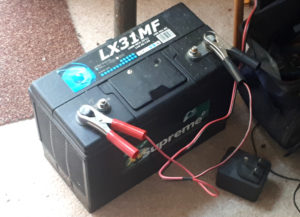 I had to make some leads for it for the power pole connectors to connect the radio; rustled those up and off I went to my location for the afternoon (see title image above, that’s the view North)… I got set up and plugged the battery in and nothing, the radio wasn’t powering up – I was cursing myself for not checking my solder/crimp joints very well… plugged in the first of the SLA batteries and all was good… (when I got it home at the end of the day it turns out that it was totally knackered, 8.5v – I knew it wasn’t a ‘good’ battery but didn’t realise it was totally knackered) – I am bloody fool!
I had to make some leads for it for the power pole connectors to connect the radio; rustled those up and off I went to my location for the afternoon (see title image above, that’s the view North)… I got set up and plugged the battery in and nothing, the radio wasn’t powering up – I was cursing myself for not checking my solder/crimp joints very well… plugged in the first of the SLA batteries and all was good… (when I got it home at the end of the day it turns out that it was totally knackered, 8.5v – I knew it wasn’t a ‘good’ battery but didn’t realise it was totally knackered) – I am bloody fool!
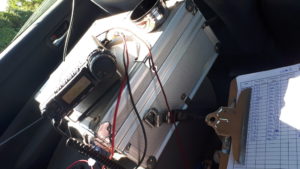
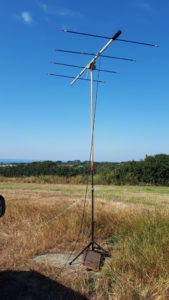
The SLA’s actually did really well – I wasn’t going to call CQ because if I did I think they would have all been dead within an hour or two so S&P (search and pounce) was to be the order of the day…
14:20 UTC – 16:51 I had 21 QSO’s – quite chuffed although I thought the numbers might have been higher… what I was really chuffed with was one from Ireland (EI9E/P) but even more pleased with GM3HAM/P (he was the 616 Km QSO) – I honestly never thought I would get that far… They most likely did all the heavy lifting with a big antenna arrangement, however I still made it 🙂
Sunday 8th July 2018
I wasn’t going to go out this AM – it’s so hot today (28 deg C) however I found myself awake early and this house doesn’t do much until lunchtime on a Sunday so I thought why the hell not… I got out to the same location and all set up for a first QSO at 07:56 UTC – scanning through I could hear only stations I had worked before however there were a couple in the mix – over 3 hours I managed to add another 14 to the log to finish on 35 QSO’s (I was later to find out I had one dupe – doh – paper logging is hard work the more you work… ha ha ha – sorry to G4NPH/P – I scanned up and down for about an hour and a half, got bored as there was no one new I could hear so packed up about 11:30 UTC – back home for some lunch and a cold beer!
Now comes the bit I dread – selecting the right section, getting it uploaded correctly in the right format – I didn’t realise but CQRlog cant export as an .edi file or .log file – I did try some other software (Minos) but couldn’t get my head around it nor see how to export to an .edi file – I really didn’t want to manually enter again the 35 in to my normal log… however it’s only 35 eh so not a huge task – anyway, with the help of M0CVO (thanks Nigel) I got in to the RSGB site for a piecemeal entry… selecting that I was a non AFS entrant and the ‘restricted’ class… it’s a slow process but it’s done – all uploaded. The system has emailed me an .edi file, now all I have to work out is how to convert it in to an .adif – if I can then it will save me having to enter it all again manually in o CQRlog – seems that clever man Mr. Smart (M1GEO) has written some Perl script (thanks for spelling correction 2M0SQL) but I’ve yet to learn what to do with that… entering them one by one again is most likely the way forward for me for now… although with additional thought I may actually work it out – as this time, I haven’t tried.
I have now – and IT WORKED (or should I say I managed to work it out (with a little assistance)) – if you are a Linux user and want your edi file in a format to import to your log, i.e. adif then this is excellent. https://www.george-smart.co.uk/software/edi_to_adif/ I am not good with Linux and I’m learning as I go so Perl and how this works I’ve no idea… but if you do it like me (detailed below) then it should sort you out – Firstly, thanks George for writing this – you saved me an hour or so of laborious typing, no idea how much time you have saved others with with this little ditty – keep up the good work! – Thank you! Thanks to Peter (2M0SQL) for his usual belligerent comments on twitter but more for the DM which just helped me understand what I was supposed to do – it may not seem you said anything much but the extra words did help my comprehension… so for those like me this is how you do it….
- Click on the link above to George’s website…
- Download the tar.gz file
- Extract
- Put your .edi file in the same folder you extracted the tar.gz file
- Follow George’s instructions on the first line
- ie – change directory (cd ) to the folder where the tar.gz file was extracted
- Then type “./edi2adif.pl input.edi output.adi“
- (‘input‘ would be the the name of your .edi file)
- (‘output‘ will be the .adi file name it creates), so name it something you remember
- Import the .adi file in to your log – simples eh 🙂
Below are screen grabs form my log submission and the ‘heat map’ of my QSO’s… really interesting and the first time I’ve done an RSGB contest (this is my 4th ever contest) so it’s the first time I’ve seen my log displayed like this.
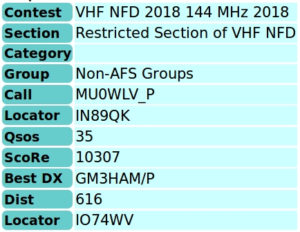
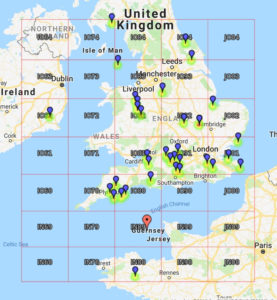

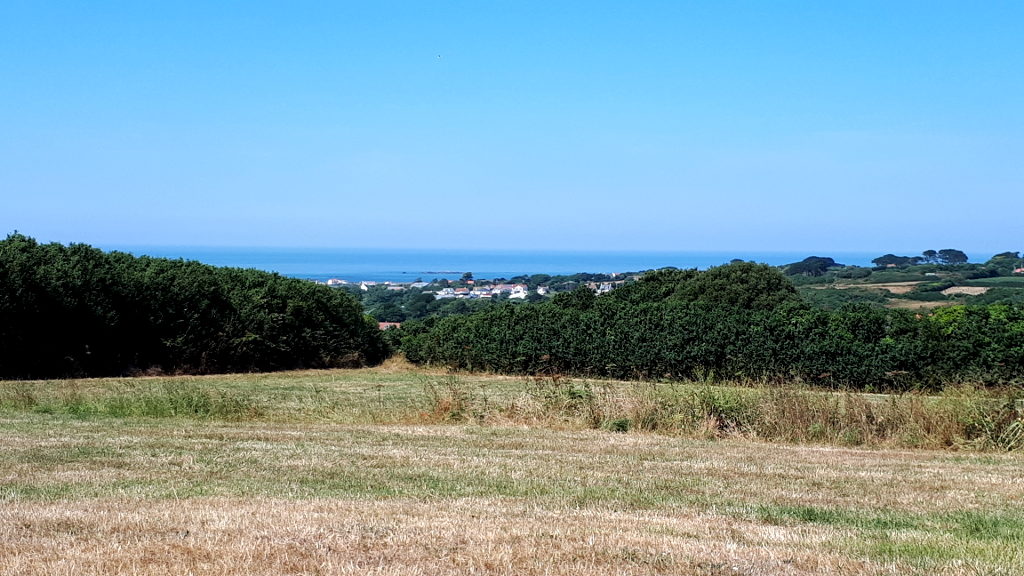
Well done mate, seems like you had fun with rf as we say at Wythall. Really good write up!
Thanks Kev – it was very enjoyable all be it bloody hot! 😉